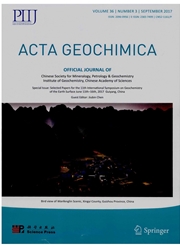

 中文摘要:
中文摘要:
post-collisional Yangba 花岗闪长岩侵入了进 Bikou metasedimentary 暴烈的组,南部的 Mianlue 缝术,华中。主人 granodiorites 包含许多 mafic 有针状的磷灰石的微小粒的被外国领地包围的土地,主人 granodiorites 的斑晶,暗示被外国领地包围的土地作为岩浆水珠被合并了到主人 granodioritic 岩浆并且经历的快速的冷却。在被外国领地包围的土地和主机岩石之间的专业和痕量元素的变化趋势关于他们的成土作用建议混合并且混合的进程。 mafic 微小粒的被外国领地包围的土地被正边粗玄岩与 SiO2 <=63%描绘, sigma(4.54-6.18)>3.3,high K2O 内容(4.22%-6.04%), K2O/Na2O > 1 ;在 K2O-SiO2 图,正边粗玄岩域里的所有样品阴谋,在 LILE 和 LREE 被充实, Ta 负异常,显示潜水艇 ducting fluid-metasomatised 披风来源。granodiorites 标明日期的锆石 LA-ICP-MS 产出 215.4 ± 8 .3 妈的年龄,显示他们在 late-orogenic 或 post-collisional 舞台期间被形成(< 242 ± 2 1 个妈) 南方 Qinling 山带。主机 granodiorites 从 su-pra-subduction 地区设定有许多近组合的类似到高硅石的 adakites,但是趋于有 K2O (3.22%-3.84%) 和 Mg#.Chon-drite-normalized 稀土元素的元素模式的更高的集中被高比率描绘(La/Yb )_N,极端 HREE 弄空和重要 Eu 异例的缺乏。与高许多 Ba 和 Sr 以及低许多 Y 和 HREE 一起,这些模式建议一个长石穷人,石榴石± a mphibole 富有的分别矿物共生。高 Mg# 值证明主机 granodiorites 被被外国领地包围的土地岩浆污染。总体上,综合地质并且 geochemical 研究建议了 Yangba granodiorites 和他们的 mafic 微小粒的被外国领地包围的土地源于充实的导出披风的 shoshonitic 岩浆混合并且变厚更低的导出外壳的 felsic 岩浆。在有以前的研究的联合,我们认为 Yangba granodiorites 是可能的在西方的 Qinling Orogenic 在迟了的 orogenic 阶段期间在 plating 活动和下地壳的分?
 英文摘要:
英文摘要:
The post-collisional Yangba granodiorite intruded into the Bikou metasedimentary-volcanic group, southern Mianlue Suture, central China. The host granodiorites contain many mafic microgranular enclaves which have acicular apatite, phenocrysts of host granodiorites, implying that the enclaves have been incorporated as magma globules into host granodioritic magma and undergone rapid cooling. The variation trends of major and trace elements between enclaves and host rocks suggest a mixing and mingling process with respect to their petrogenesis. The mafic microgranular enclaves are characterized by shoshonite with SiO2≤〈63%, σ (4.54-6.18)〉3.3, high K2O content (4.22%-6.04%), K2O/Na2O〉1; in the K2O-SiO2 diagram, all the samples plot in the shoshonite field, which are enriched in LILE and LREE, with obvious Nb, Ta negative anomalies, indicating a subducting fluid-metasomatised mantle source. Zircon LA-ICP-MS dating of the granodiorites yielded an age of 215.4±8.3 Ma, indicating they were formed during the late-orogenic or post-collisional stage (≤242±21 Ma) of the South Qinling Mountain Belt. The host granodiorites have many close compositional similarities to high-silica adakites from supra-subduction zone setting, but tend to have a higher concentration of K2O (3.22%-3.84%) and Mg^#. Chondrite-normalized rare-earth element patterns are characterized by high ratios of (La/Yb)N, the extreme HREE depletion and a lack of significant Eu anomalies. In conjunction with the high abundances of Ba and Sr as well as the low abundances of Y and HREE, these patterns suggest a feldspar-poor, garnet ± amphibole-rich fractionation mineral assemblage. High Mg^# values demonstrate that the host granodiorites were contaminated by enclave magma. On a whole, integrated geological and geochemical studies suggested the Yangba granodiorites and their mafic microgranular enclaves resulted from mixing of enriched mantle-derived shoshonitic magma and thickened lower crust-derived felsic magma. In combination w
 同期刊论文项目
同期刊论文项目
 同项目期刊论文
同项目期刊论文
 Genesis of the Madang Cenozoic sodic alkaline basalt in the eastern margin of the Tibetan plateau an
Genesis of the Madang Cenozoic sodic alkaline basalt in the eastern margin of the Tibetan plateau an Partial melting of thickened Tibetan crust: geochemical evidence from Cenozoic adakitic volcanic roc
Partial melting of thickened Tibetan crust: geochemical evidence from Cenozoic adakitic volcanic roc Geochemistry and Sr-Nd-Pb isotopic characteristics of the Mugouriwang Cenozoic volcanic rocks from T
Geochemistry and Sr-Nd-Pb isotopic characteristics of the Mugouriwang Cenozoic volcanic rocks from T 期刊信息
期刊信息
